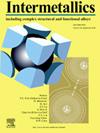Effect of Co element on microstructure and softening behavior of NiW medium heavy alloy
IF 4.3
2区 材料科学
Q2 CHEMISTRY, PHYSICAL
引用次数: 0
Abstract
In this study, a novel Ni-42W-XCo-1Mo medium heavy alloy (X = 0, 5, 10, 15, 20, wt%) was designed, and the impact of Co element on the microstructure and mechanical properties was investigated. The results indicated that the addition of Co effectively inhibited the formation of topologically close-packed (TCP) phases, which decreased with the addition of Co and reached a minimum in the Ni-42W-10Co-1Mo alloy. The yield strength of the Ni-42W-XCo-1Mo medium heavy alloy decreased with increasing Co content at both room temperature and high temperatures (750 °C). Specifically, the room-temperature yield strength of Ni-42W-1Mo alloy decreased from 516 MPa to 368 MPa after addition of 20 wt% Co, as well as the microhardness decreased from 271 HV to 233 HV. It was attributed to Co weakened precipitated strengthening effect and induced softening effect. Moreover, the Portevin-Le Chatelier (PLC) effect was observed in the Ni-42W-XCo-1Mo alloys during high temperature compression, which was attributed to the continuous dissolution and precipitation of the TCP phase repeatedly, leading to dislocation pinning and unpinning. Moreover, the Ni-42W-XCo-1Mo alloys showcased exceptional ductility, withstood up to 60 % strain without fracturing due to the face-centered cubic (FCC) matrix.
求助全文
约1分钟内获得全文
求助全文
来源期刊

Intermetallics
工程技术-材料科学:综合
CiteScore
7.80
自引率
9.10%
发文量
291
审稿时长
37 days
期刊介绍:
This journal is a platform for publishing innovative research and overviews for advancing our understanding of the structure, property, and functionality of complex metallic alloys, including intermetallics, metallic glasses, and high entropy alloys.
The journal reports the science and engineering of metallic materials in the following aspects:
Theories and experiments which address the relationship between property and structure in all length scales.
Physical modeling and numerical simulations which provide a comprehensive understanding of experimental observations.
Stimulated methodologies to characterize the structure and chemistry of materials that correlate the properties.
Technological applications resulting from the understanding of property-structure relationship in materials.
Novel and cutting-edge results warranting rapid communication.
The journal also publishes special issues on selected topics and overviews by invitation only.
 求助内容:
求助内容: 应助结果提醒方式:
应助结果提醒方式:


